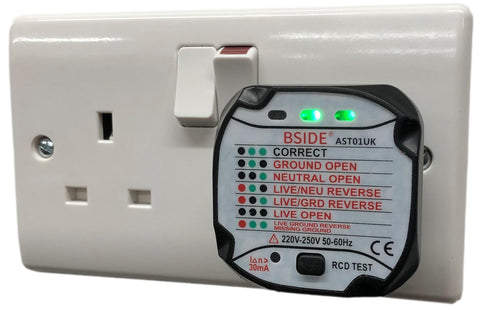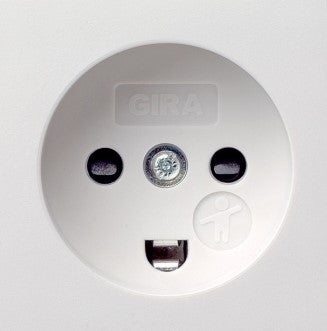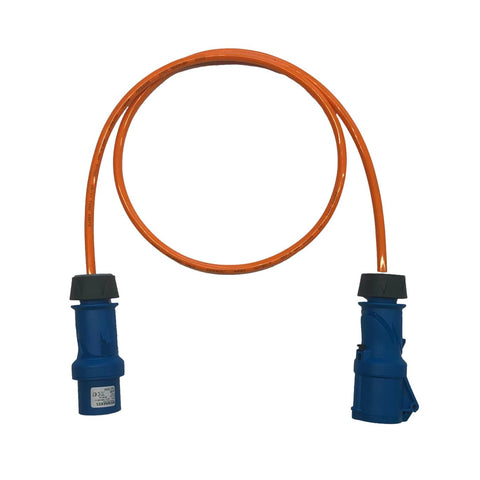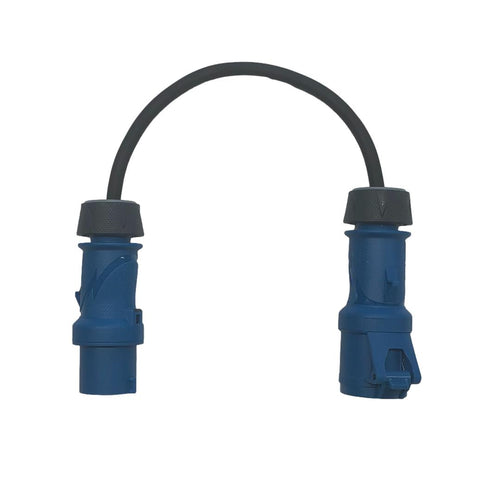Connecting your caravan or motorhome to electricity in the UK, US & Europe
For simplicity, the term 'motorhome' is used in this guide to refer to any type of caravan, motorhome or other vehicle with an electrical connection. For converted ambulances and emergency vehicles, more specific advice is available here.
What is a motorhome power inlet?
Connecting a motorhome to an electrical supply, enables use of the internal lights and appliances. Motorhomes are fitted with a power inlet for this purpose, which is often found under a plastic flap, with the connector itself being blue.

What is a hook-up cable?
A hook-up cable is used to connect the motorhome power inlet to an electrical supply, such as at a camping site. It has a male IEC60309 plug at one end and a female IEC60309 socket at the other.
Purchasing a cable which meets the IET Wiring Regulations (BS 7671) is key to ensuring a safe connection, for the protection of your vehicle and family.
Connectors
Across the UK and Europe, the standard connection for motorhomes is a 230v 16A IEC60309 connector, also known as a 'Commando' connector. These are normally all or partly blue in colour, with an external diameter of 43mm.
Whilst the 230v 16A IEC60309 connectors from any brand can be used interchangeably, there are significant differences in the quality. Cheap online leads often use the Chinese made connector (left), which has a plastic thickness of just XXmm. In contrast we only use high quality German manufactured connectors, which are significantly more robust, with a plastic thickness of XXmm.

Cable Diameter
The IET Wiring Regulations specify that hook-up cables must be 2.5mmsq; this refers to the size of the inner cores, not the overall diameter of the cable itself. Cheap hook-up cables for sale on many large online marketplaces use 1.5mmsq flex. These do not comply with the IET Wiring Regulations and must not be used due to the risk of over-heating with higher loads.
Imagine watering your garden with a 25m hose pipe. The hose pipe exerts resistance on the flow of water. The longer the pipe, the more resistance is experienced by the water as it flows through, resulting in lower pressure at the end. This same principle applies to electricity flowing through a cable. The longer the cable, the more resistance is exerted on the flow of electricity. Just like the pressure is reduced at the end of a long hose pipe, voltage is reduced at the end of a cable. The smaller the diameter of the cable, the more the voltage reduces with each metre. As the voltage drops, appliances draw more current to compensate, resulting in reduced performance and an increased risk of overheating.
Cable Length
The standard length for hook-up leads is 25m, as many sites operate a 20m maximum distance to power bollards. It's always advised not to use longer leads or daisy chain two cables together, but why? As a cable gets longer it's resistance increases. As described in the section above, this leads to excessive voltage drop and an increased risk of overheating.
Leads must not be used when coiled, either in the open air, or on a reel. Using a lead which is still coiled, can lead to the build up of heat, with catastrophic results. Excess cable should be placed under the motorhome in a lose pattern, avoiding coiling.

Cable Type
Most hook-up leads use blue or orange ‘arctic’ flex. Yellow arctic cable was originally designed for 110v construction site use, where it offered flexibility down to -25°C. Whilst blue and orange 230v versions are available, they are not tested to the same standards and are not recommended for use below 5°C. The cable is prone to mechanical and UV damage. Further information on the significant limitations of artic cable can be found in Wiring Matters.

Whilst our cables are also orange and look very similar, they are in an entirely different league. The cable has a silicone appearance and is exceptionally tough. It is in fact a rubber industrial grade cable, specifically designed for use in harsh environments such as marine and construction. It benefits from a high resistance to mechanical, chemical, water and UV damage. Flexibility and performance are retained over a wide temperature range (-40 to 90°C). We know that our leads are more expensive than our competitors. The price difference is down to the superior cable and connectors, which are built in our UK workshop to provide a significantly longer service life.
How do I connect to a power supply?
Check the Hook-up Cable
- Carefully check the entire length of the hook-up cable for any signs of damage.
- Check that each connector is undamaged and the cable is held firmly into place. The inner cores must not be visible.
- Check the contacts of the motorhome inlet and the hook-up lead plug/socket for signs of corrosion or over heating. Corrosion can cause a poor electrical connection, leading to overheating. Heat damage will cause the metal to turn darker, often with a multicoloured pattern. The plastic may also be melted, particularly around the contact.
Prepare the Motorhome
- Turn off the motorhome consumer unit main switch/RCD (on the right of the pic).
- Connect the hook-up lead socket to the motorhome inlet.

Connect to the power supply
- Find the nearest power supply and check that it provides electricity at 230-250v.
- All site power connections must be protected by and RCD. A Residual Current Device (RCD), is a life-saving device which is designed to prevent you from getting a fatal electric shock if you come into contact with a live connection. Press the test button and check that the RCD trips (the lever switch on it will flick downwards). Reset the RCD by pushing the lever switch upwards.
- Ensure that if a rotary switch is provided for the supply socket, it is turned off.
- Plug the hook-up plug into the supply socket. Turn on the rotary switch (where fitted)
- Be mindful of how the cable is routed, to avoid creating any hazards. Cables must not pass over roads.
- Excess cable should be placed under the motorhome in a lose pattern, avoiding coiling.
Check the Connection
- Turn on the motorhome consumer unit main switch/RCD.
- Press the RCD test button to ensure that it trips (the lever switch on it will flick downwards). Reset the RCD by pushing the lever switch upwards

- Plug in a 13A socket tester to one of the sockets within the motorhome to confirm that the supply is the correct polarity and there is an earth connection.

How do I disconnect from a power supply?
- Turn off the motorhome consumer unit main switch/RCD.
- Where present, switch off the rotary isolator on the supply socket. Some sockets have a small red button which has to be pressed to remove the plug.
- Remove the hook-up lead plug from the supply.
- Remove the hook-up lead socket from the motorhome.
- Check the cable and connectors for any signs of damage.
How much power can I use?
The total amps that can be drawn from the supply may be noted on a sign. Where it is not clear, it can be determined by looking at the circuit breakers in the supply hook up enclosure. The rating is stated after the letter B or C e.g. on the example below B16 = 16A.
There are two different configurations on camping sites:
- Left - Separate RCD to protect against the risk of shock and an MCB to protect the installation from overloading, short circuit etc. With this configuration you need to read the rating stated on the MCB (16A in the example).
- Right - A single RCBO, which is a combined RCD and MCB. You need to read the rating stated on this (16A in the example).

Power supplies in the UK typically provide 16A, but in Europe they are commonly 6A, 10A or 16A.
The simplest way to calculate the power that your motorhome requires is to look at the label on each appliance. To convert watts to amps, divide it by 230 e.g. a 1000 watt heater will take 4.35 amps. Our generator page provides a downloadable spreadsheet to enable a more accurate calculation.
A plug in meter can also be used to show the live and cumulative power used by the motorhome.
Can I connect to a 13A domestic socket?
A 13A plug to 16A commando socket adaptor can be used to connect a motorhome to a UK 13A socket. Slightly confusingly, whilst UK sockets are commonly referred to as 13A, they can only supply 13A for short periods of time e.g. boiling a kettle. For prolonged loads, 10A is the maximum to avoid over-heating.
Can I use a generator?
In the absence of an available power connection, a generator can be used to provide electricity. Further information on how to select the right type and size of generator can be found in our guide. In order for the motorhome RCD to operate, it is important that either an earth electrode is used with the generator, or an electrician installs an earth-neutral link. We sell a range of high quality inverter generators here.

Can I use an electric vehicle charging point to provide power?
It's a little known fact, that you can actually use certain electrical vehicle (EV) charging points to provide power to motorhomes. A special adaptor is needed to safely convert the EV socket to a standard camping connector. The adaptor plugs into any type 2 EV socket, which are the most common EV connector across the UK and Europe, and then connects to the hook-up lead.



It will only work with chargers which have a socket, not those which have a tethered lead with the EV connector on the end e.g. fast chargers.

The amount per kWh varies between providers, with the highest being at fast chargers. As the adaptor works with slower type 2 only points and the unit will only charge for the energy used, this keeps costs to a minimum. For longer road trips where solar alone is not sufficient, the use of EV chargers can prove significantly cheaper than other options, such as renting a pitch for the night.
How do I connect to power at campsites abroad?
Many European campsites have the same blue IEC60309 'Commando' socket used in the UK, so a standard UK hook-up leads can be used.
However, in France, some campsites provide only French sockets. French sockets have two holes for the plug, and then a pin which protrudes from the socket to provide the earth connection.

To connect to a French socket, you will need a European plug to 230v 16A IEC60309 adaptor. This simply connects to the end of the hook-up lead.

Reverse Polarity
The problem of reverse polarity is often discussed on caravaning forums, but what actually is it and it is really such an issue? All connectors used within the UK are polarised; they can only be inserted one way into a socket. This means that the live is always on the same pin and neutral on the other.
However, abroad and in France in particular, sockets are often wired with the live and neutral either way around. A UK motorhome is wired on the basis that the live will be the live. Circuit breakers often just switch off the live in the case of a fault. If the campsite socket is wired the wrong way round, then they will switch the neutral. In practical terms, this means that whilst the equipment in the motorhome will appear to be off, the live connection will still very much be live. The even greater risk is that the RCD in the motorhome, which provides protection against a shock, will either fail to operate, or will switch off the neutral - leaving you to continue to be electrocuted!
Always use a socket tester in a socket in your motorhome once connected to a power supply.
When travelling in Europe always carry a polarity reversal adaptor. If the live and neutral are reversed, simply plug in the adapter to the motorhome hook-up lead and it will correct the issue.
Why is an earth connection so important?
When connected to an external power supply, motorhomes require an earth connection to operate safely. If an earth connection is present, then if a fault occurs making the metal body of the motorhome live, electricity would flow down the earth wire, quickly cutting off the power. However, if there was no earth connection, the body would remain live. If you were to touch it, electricity would flow through your body to the ground, with potentially fatal consequences.
Always use a socket tester to check that there is an earth connection; never assume that just because a socket has a visible earth receptacle/pin, that it is actually wired correctly.
How do I connect to domestic power sockets abroad?
The map below shows the different types of sockets in use across Europe and Scandinavia. The IEC provide the definitive guide to which plugs and sockets are used in every country of the World.

|
Schuko
French
|
Universal Schuko/French Adaptor The Schuko/French universal adaptor has a CEE7/7 plug, which is compatible with both the French (grey on the map) and German (light blue) sockets used in Albania, Belgium, Bosnia and Herzegovina, Bulgaria, Czech Republic, Finland, France, Germany, Greece, Hungary, Iceland, Italy (modern installations only), Latvia, Lithuania, Luxembourg, Macedonia, Moldova, Netherlands, Norway, Poland, Portugal, Romania, Russia, Serbia, Slovakia, Slovenia, Spain, Sweden, Turkey and Ukraine |
|
Traditional Italian Socket
New Bipasso Socket
|
Italian Adaptors 10A and 16A Historically Italy has had its own specific socket, available in 10A and 16A versions. However, many buildings now have the Bipasso/Schuko socket, which can be used with both Italian and Schuko plugs. The universal Schuko/French adaptor will therefore work anywhere in Italy where the Bipasso/Schuko socket is available. However, the challenge may be in older buildings, where only traditional Italian sockets are provided. Whilst many sockets in Italy will accept both 10A and 16A plugs, some will only accept one type, so for complete peace of mind both the 10A Italian and 16A Italian adaptors would be required. Alternatively, just the 10A version could be used as it will fit both sockets, although the max load is 10A. |
 |
Swiss Adaptor Switzerland and Liechtenstein use their own specific socket, available in 10A and 16A versions. 10A plugs can be inserted into 16A sockets, but the reverse is not possible. For complete peace of mind both the 10A Swiss and 16A Swiss adaptors would be required. Alternatively, just the 10A version could be used as it will fit both sockets, although the max load is 10A. |
 |
Danish Adaptor Denmark and Greenland use their own 16A socket. Whilst the socket looks similar to a Schuko/French socket, they must not be used together. Although they will fit, the earth will not be connected, which is extremely hazardous. The Danish adaptor must be used for these sockets. From 2008 French sockets were allowed to be fitted in Denmark, with Schuko sockets supported from 2011. The universal Schuko/French adaptor will therefore work in Denmark where either of these sockets are fitted. Data on their prevalence is not available, and so it is likely that in many places a Danish adaptor will still be required. |
Can I connect to industrial sockets?
IEC 60309 (Commando) connectors have become the standard for electrical connections in commercial and industrial premises across Europe since their introduction in the 1960s. Using the correct adaptor, motorhomes can be connected to industrial sockets.
|
57mm diameter |
230v 32A Blue Sockets (IEC 60309) Looks similar to the standard motorhome connector, but has a larger 57mm overall diameter. Use this adaptor. |
|
56mm diameter |
415v 16A Red Sockets (IEC 60309) Commonly used in industrial locations and power installations at temporary sites. The adaptor is only compatible with 5 pin sockets (L1, L2, L3, N And E), as motorhomes require a neutral connection. Use this adaptor. |
|
63mm diameter |
415v 32A Red Sockets (IEC 60309) Commonly used in industrial locations and power installations at temporary sites. The adaptor is only compatible with 5 pin sockets (L1, L2, L3, N And E), as motorhomes require a neutral connection. Use this adaptor. |
How do I connect to power at RV sites in the US and Canada?
Motorhomes Requiring 230v
The standard domestic voltage in the US and Canada is 120v. As UK/European motorhomes are designed to operate on 230v, a transformer is required to increase the voltage (unless the inlet purely powers a battery charger - see next section). There are three different types of socket provided at campsites.

NEMA 5-20 or 5-15 (right)
The NEMA 5-20 socket provides a 120v 20A supply. The neutral receptacle is T shaped to enable both the 20A NEMA 5-20 plug which has a horizontal neutral blade and the NEMA 5-15 with a vertical blade to be connected.

A step up transformer is required and works by converting the 120v supply to 230-240v. Our NEMA 5-15 to IEC 60309 110v 16A socket adaptor is connected to the socket, and then connects to the yellow plug of the transformer. The motorhome standard hook up cable plugs into the transformer.
When using any step-up transformer, you need to be aware of the following considerations:
- The equation power (w) = current (I) and volts (v), means that an appliance using 1000w of power will pull 8.3A from a 240v supply (1000/240=8.3) . A transformer powering the same appliance will need to pull twice as much current (16.6A) from the 120v supply.
- Most step-up transformers can only supply the stated maximum load for intermittent periods, typically 5min on, 15min off. In reality this means that they can only supply around half the maximum stated power continually.
NEMA 30TT (middle)
The NEMA 30TT is the most common socket available at US RV sites and provides a 120v 30A supply. As per the NEMA 5-15/20 socket, a step-up transformer is required, as detailed above. Our NEMA 30TT to IEC 60309 110v 16A socket adaptor is connected to the socket, and then connects to the yellow plug of the transformer.

NEMA 14-50 (left)
The NEMA 14-50 is a four pole connector, which has two live connections and is rated at 50A. 120v is provided between live 1 (X) and neutral, with 120v also provided between live 2 (Y) and neutral. US motorhomes use this to provide two parallel 120v connections. Unfortunately it cannot be used to provide a 240v supply to motorhomes, as 240v is only available between the 2 lives; UK/European motorhomes require 230-240v between live and neutral.

Motorhomes Which Can Operate at 110-125v
Some motorhomes have a power inlet purely to power a battery charger, with all other electrics operating from the battery. If the charger is rated to operate at 110-125v, then there is no need for a step up transformer. Contact us for custom adaptors with a 230v 16A CEE commando blue socket.













